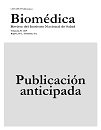Standardization of the use of zymosan as an additional stimulus in the 1,2,3-dihydrorhodamine technique for the assessment of neutrophil respiratory burst
Abstract
Introduction. Chronic granulomatous disease (CGD) is a defect in phagocytosis due to deficiency of gp91phox, p22phox, p47phox, p40phox and/or p67phox (classic-CGD). Recently, EROS and p40phox deficiency were described as responsible for non-classical CGD. The 1,2,3-dihydrorhodamine (DHR) oxidation technique using phorbol-12-myristate-13-acetate (PMA) as a stimulus is performed for the diagnosis of classic-CGD. However, EROS and p40phox require the use of stimuli such as zymosan, Escherichia coli or Staphylococcus aureus for their detection.
Objective. To optimize the DHR technique using zymosan for the detection of non-classical CGD to be developed in clinical diagnostic laboratories.
Material and methods. Blood was obtained from five healthy subjects with prior informed consent. The DHR technique was performed using PMA as control and different concentrations of opsonized zymosan (150, 100, 50, 20 and 10 µg). We obtained by flow cytometry the mean fluorescence intensity (MFI) of 1,2,3-rhodamine in neutrophil population and calculated the oxidation index. The Kolmogorov-Smirnov test, ANOVA and Tukey's post-hoc analysis was used. We considered the value of p=<0.05 as statistically significant.
Results. PMA produced increased MFI of 1,2,3-rhodamine in healthy subjects. Among the different zymosan conditions tested, we selected 50 µg zymosan as the optimal and reproducible amount in all controls by statistical analysis and cytometric findings.
Conclusions. We present the optimization of the DHR technique using zymosan. We propose its implementation in clinical diagnostic laboratories to expand the diagnosis of CGD.
Downloads
Copyright (c) 2024 Biomedica

This work is licensed under a Creative Commons Attribution 4.0 International License.
| Article metrics | |
|---|---|
| Abstract views | |
| Galley vies | |
| PDF Views | |
| HTML views | |
| Other views | |


























